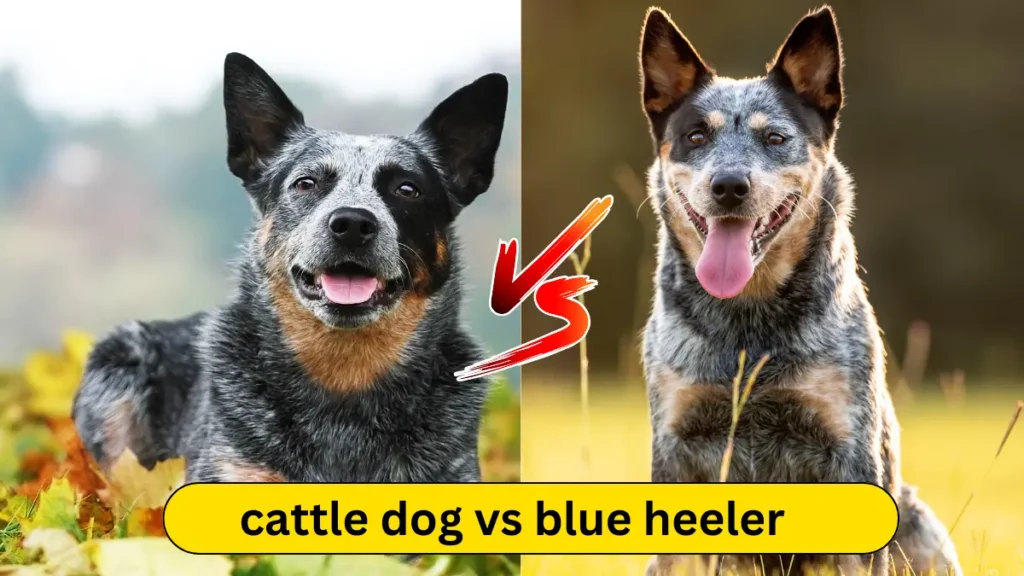When discussing loyal, hardworking, and intelligent dog breeds, the Cattle Dog vs Blue Heeler debate often arises. These terms are frequently used interchangeably, leading to some confusion about whether they refer to the same dog breed or if there are distinctions between the two. This article will explore the origins, characteristics, and key differences between the Australian Cattle Dog and the Blue Heeler. By the end, you’ll have a clear understanding of what sets them apart and how they compare.
Cattle Dog vs Blue Heeler Comparison
What Is a Cattle Dog?
The Australian Cattle Dog, commonly known as a Cattle Dog, was initially bred in Australia in the 19th century to herd cattle over long distances in rough terrain. They are recognized for their stamina, intelligence, and strong work ethic, making them perfect for farm work and various canine sports. These dogs are known for their tenacity and energy, and they require significant mental and physical stimulation to thrive.
What Is a Blue Heeler?
A Blue Heeler is essentially a type of Australian Cattle Dog. The term “Heeler” comes from their natural herding instinct, as these dogs tend to nip at the heels of cattle to direct them. The “blue” in Blue Heeler refers to the color of the dog’s coat, which is a mix of black and white that appears bluish from a distance. There is also a Red Heeler variation, distinguished by its reddish coat, but in this article, we focus on the Blue Heeler.
Cattle Dog vs Blue Heeler: Are They the Same?
At their core, the Cattle Dog vs Blue Heeler question boils down to terminology. The Blue Heeler is a variation of the Australian Cattle Dog, but both refer to the same breed. The primary difference lies in the coat color and the regional terms used to describe them. So, technically speaking, all Blue Heelers are Australian Cattle Dogs, but not all Australian Cattle Dogs are Blue Heelers since some may have a red coat.
Key Similarities Between Cattle Dogs and Blue Heelers
Even though the terms may vary, there are several key similarities between Cattle Dogs vs Blue Heelers that unite them:
- Breed Origin: Both terms refer to dogs that were bred in Australia for herding cattle.
- Temperament: Both are known for being intelligent, loyal, and protective of their families.
- Work Ethic: These dogs are hardworking and thrive in environments where they have a job to do, whether it’s herding or engaging in dog sports like agility or obedience training.
- Energy Levels: Both Cattle Dogs and Blue Heelers have high energy levels and require daily exercise to prevent behavioral issues.
- Size: Both types are medium-sized dogs, typically weighing between 35-50 pounds and standing around 17-20 inches tall at the shoulder.
Characteristics That Define the Blue Heeler
While Blue Heelers share many traits with other Australian Cattle Dogs, their unique coat color and slight variations in temperament can make them stand out:
- Coat Color: The Blue Heeler has a distinctive blue or bluish-gray coat, often speckled or mottled with black and white.
- Temperament: Blue Heelers tend to be slightly more reserved and cautious around strangers compared to other Australian Cattle Dogs, though this can vary depending on socialization and training.
- Herding Instinct: Blue Heelers often have a stronger instinct to nip at heels while herding, which is why early training is essential to ensure this behavior doesn’t transfer to people.
Differences Between Cattle Dogs and Blue Heelers
Although there aren’t significant differences between Cattle Dogs vs Blue Heelers in terms of breed classification, some subtle distinctions are worth noting:
- Terminology: “Cattle Dog” is a broader term used globally, while “Blue Heeler” is a more specific descriptor used in Australia and certain regions to refer to the blue-coated variation.
- Coat Colors: The main difference between the two lies in coat color. Cattle Dogs can be Blue Heelers or Red Heelers, depending on their coat. Blue Heelers have a bluish-gray appearance, while Red Heelers have a reddish coat.
Training and Socialization
Regardless of whether you have a Cattle Dog or a Blue Heeler, training and socialization are crucial. Both dogs are intelligent and eager to please but can also be independent and stubborn at times. Early socialization with other dogs and people is essential to prevent excessive guarding behavior, and positive reinforcement training is highly recommended for best results.
Grooming Needs
The grooming needs of Cattle Dogs vs Blue Heelers are similar. Both have short, dense coats that are relatively easy to care for. They do shed, especially during seasonal changes, so regular brushing is recommended to manage shedding and keep their coat healthy. Additionally, checking their ears for debris, trimming their nails, and ensuring dental hygiene are important parts of their grooming routine.
Health Concerns
When considering the health of Cattle Dogs vs Blue Heelers, it’s important to be aware of common health issues that can affect both variations of the breed:
- Hip Dysplasia: This is a common genetic condition that affects many medium-to-large dog breeds. Regular vet check-ups and maintaining a healthy weight can help manage this condition.
- Progressive Retinal Atrophy (PRA): PRA is an eye disorder that leads to gradual blindness. Regular eye exams can help detect this condition early.
- Deafness: Some Australian Cattle Dogs, particularly Blue Heelers, are prone to congenital deafness. It’s recommended to have puppies’ hearing checked early in life.
Which Dog Is Right for You?
If you’re trying to decide between a Cattle Dog vs Blue Heeler, it’s important to assess your lifestyle and what you’re looking for in a dog. Both variations of the Australian Cattle Dog are ideal for active individuals or families with plenty of time to dedicate to exercise, training, and socialization.
- For Active Families: Either the Cattle Dog or Blue Heeler is a great fit if you’re an active family who enjoys outdoor activities like hiking, running, or even agility training.
- For Farms or Rural Areas: Given their strong herding instincts, Cattle Dogs and Blue Heelers thrive in environments where they have a job to do. Farms or homes with large yards where they can run and work are ideal.
- For First-Time Dog Owners: These dogs are incredibly loyal but can be a challenge for first-time dog owners due to their high energy and need for consistent training. If you’re new to owning a dog, you may want to consider consulting with a professional dog trainer.
Conclusion
In the Cattle Dog vs Blue Heeler debate, the distinction largely comes down to terminology and coat color. The Blue Heeler is simply a type of Australian Cattle Dog with a specific blue or grayish coat. Both are loyal, hardworking dogs that excel in active environments and require significant physical and mental stimulation. Whether you choose a Cattle Dog or a Blue Heeler, you’re getting a smart, devoted, and energetic companion that will bring joy and adventure to your life.
FAQs About Cattle Dog vs Blue Heeler
What is the difference between a Cattle Dog and a Blue Heeler?
The main difference between a Cattle Dog and a Blue Heeler lies in terminology and coat color. A Blue Heeler is a type of Australian Cattle Dog with a bluish-gray coat, while Cattle Dogs can have either blue or red coats.
Are Blue Heelers more aggressive than other Cattle Dogs?
Blue Heelers are not necessarily more aggressive, but they can be more reserved and protective due to their strong herding instincts. Early socialization and training are key to managing this behavior.
How much exercise do Blue Heelers and Cattle Dogs need?
Both Blue Heelers and Cattle Dogs are high-energy breeds that require at least 1-2 hours of exercise per day. Activities like running, hiking, or playing fetch are great ways to keep them engaged.
Do Blue Heelers shed more than other Australian Cattle Dogs?
Both Blue Heelers and other Australian Cattle Dogs have similar shedding patterns. They are moderate shedders, but their shedding increases during seasonal changes.
Can Blue Heelers and Cattle Dogs be good family pets?
Yes, both Blue Heelers and Cattle Dogs can be excellent family pets, especially for active families. However, they require consistent training and socialization to ensure they behave well around children and other pets.


